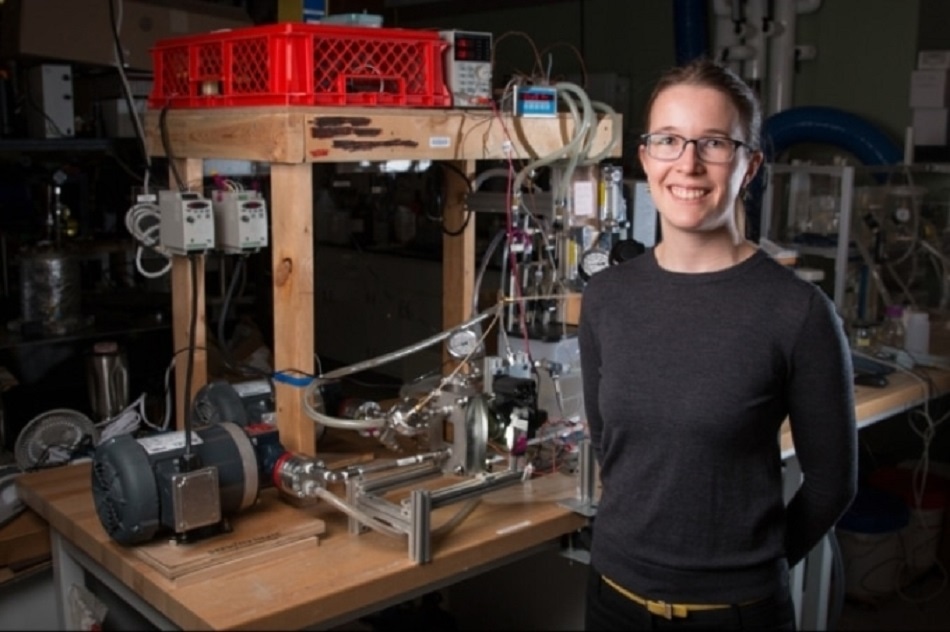 Image:Courtesy of the Researchers
Image:Courtesy of the Researchers
Fouling of membranes by microorganisms is a huge headache for the desalinization industry, and is blamed for the high cost of the reverse osmosis process used in most plants today. Researchers from MIT have suggested a new approach which could reduce the rate of fouling and improve efficiency.
The desalinization industry generated more than $13 billion last year – a figure expected to double within the next decade. Most plants use reverse osmosis (RO), a process which forces water through massive rolls of membrane to remove salts. However, these membranes become contaminated by microorganisms – the result of the high pressure required for RO many in the industry believe.
The prevailing idea is that the high pressure in an RO system compresses the microbial mats that grow on the membrane and this squashing makes the growth much harder to remove. But this is not the case, say the Massachusetts Institute of Technology (MIT) Researchers: the microbial mats are generally full of water, which does not compress under RO pressures.
There is no good reason why high pressure should worsen fouling.
Emily Tow, PhD Graduate, MIT, 2017
Tow, now an ITRI-Rosenfeld Postdoctoral Fellow at Lawrence Berkeley National Laboratory, compares the microbes to a scuba diver, "There's a lot of pressure at the bottom of the ocean, but it doesn't make you stick to the seafloor."
So if pressure doesn't matter, and flow rates for RO and FO – forward osmosis which is less energy efficient but more foul-resistant – are similar, what causes the difference in fouling resistance?
Researchers devised a new approach to isolating the effects of pressure from other differences between FO and RO. It involves operating an FO system – which uses osmosis to pull rather than push water through membranes – at a range of pressures up to 40 atmospheres.
We measured fouling rates and cleaning outcomes, and even recorded video of the membranes being cleaned at various pressures, and we found no effect of pressure.
Emily Tow, PhD Graduate, MIT, 2017
Previous research has suggested pressure is the issue, but these experiments also varied the concentration of the solution on the back side of the membrane when also varying pressure. By raising the pressure on both sides of an FO system without changing other variables, MIT’s study revealed that pressure does not speed up fouling, nor impeded cleaning of the membranes.
Now the team had proved that high pressure – which is essential for RO to work – does not affect fouling, their next step was to look for other reasons why processes like FO are more anti-fouling and see if they could be applied to RO.
The observation that forward osmosis membranes are easier to clean is fairly robust.
Professor John H Lienhard, the Abdul Latif Jameel Professor of Water and Food and Director of the Center for Clean Water and Clean Energy and the Abdul Latif Jameel World Water and Food Security Lab
The new study shows that FO's fouling resistance, "Is not intrinsic to its low pressure. The difference must be related to other factors that could potentially be transferrable to RO. It needs to be understood," Leinhard continued. “The hope is that with further work, this could make it easier to clean RO membranes.”
The difference in how fouling affects RO and FO membranes could be attributed to the membrane's support layer, the backing on the thin, salt-filtering layer. In FO, interactions between the support layer and the concentrated solution it touches influence how the water flows through the membrane, which dictates how foulants build up on the membrane surface, Tow says.
Future RO membranes could be designed so that fouling occurs in a pattern similar to that of FO, or even a new pattern optimized for easy cleaning.
Improving the ability to clean used membranes could affect not only water cost but also the reliability of desalination plants, Lienhard points out, "Shutdowns because of an algal bloom can sometimes interrupt the supply of water for days or weeks on end.”
Understanding the fundamentals of fouling, including the effect of pressure, could enable development of more targeted fouling mitigation methods.
Disclaimer: The views expressed here are those of the author expressed in their private capacity and do not necessarily represent the views of AZoM.com Limited T/A AZoNetwork the owner and operator of this website. This disclaimer forms part of the Terms and conditions of use of this website.